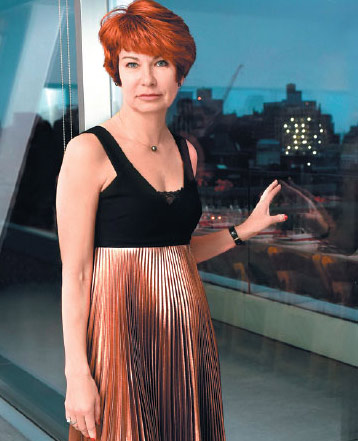Art is My Domain
By Natacha Riva ( China Daily ) Updated: 2017-08-12 09:05:32
 |
|
Elena Chinyaeva, chief adviser to.art. LEANDRO JUSTEN/BFA.COM, RHIZOME AND.ART |
Elena Chinyaeva is the chief adviser to .art - which oversees the new internet domain extension - on business development and communications. She explains the impetus behind the launch of.art and the growing presence of art-focused websites
What exactly is .art?
It's the art world's exclusive web domain. In addition to .com, .org,.gov and about 20 other older domain zones, the internet of today has many more new generic top-level domain zones (gTLDs) and.art is one of them. Since the onset, the vision of.art has been to create an online ecosystem for art, where everyone from established art organizations to emerging artists can identify themselves as members of the art community, and connect with like-minded individuals and organizations from the art world. .Art was not designed to serve an elite community but everyone, from institutions and artists to companies and individuals from fields as broad as art, design, luxury, tech, education, health, sports and entertainment.
So why start .art now?
.Art launched in early December last year, but the preparations started five years ago. Back in early 2012, ICANN (the internet Corporation for Assigned Names and Numbers) - the controlling body of the internet - announced its new gTLDs program, which was an initiative to expand the existing system of web extensions to give users more choice in acquiring their internet identities. There were 10 applications for.art - which makes it one of the most contested domain zones ever, as the name is both short and clear in meaning. When it comes to domain name systems (DNS), the shorter and clearer, the more valuable. The popularity of.art has also reflected the fast growth of a relatively new segment of the art market - art online. A few years ago, it was a novelty for a gallery or an artist to have an online presence, but now it's a must.
Where does .art stop and .biz or .com start?
As the founder of .art, venture investor Ulvi Kasimov likes to say: "In the digital era, we have a digital dress code." Different digital identities serve different purposes - anyone can have several. If you're commercial, you might try to secure a presence on .com or.biz; if you're creative, you may opt for .art.
How did you acquire the right to administer the.art domain?
The new gTLDs program in 2012 allowed anyone to apply for any number of domain names, provided they complied with certain rules and paid the necessary fees. We applied for one name only - .art - and found ourselves in the company of nine other powerful competitors. The contention was then resolved through a private auction in July 2015, which we won. Then there was a compliance procedure; finally in 2016, we signed a contract with ICANN for operating an.art registry. Since then, some of our former competitors have become our partners, like the New York-based media platform e-Flux, which has helped .art attract art professionals from around the world by using its strong database of contacts.
How can you determine what gets .art status and what doesn't? For example, watchmaker Rolex and fashion house Chanel both have art credentials, but neither is specifically recognized as an art world player.
Registrants are buying .art names for different purposes. At the very least, one can protect its brand or personal name, so that others can't claim it for speculation or abuse. Google, Apple, WhatsApp, AXA, Bank of America Merrill Lynch and other high-tech and financial giants mostly bought their .art names for protection purposes - often several, for each of their branded products as well.
Other well-established commercial entities - luxury brands among them - are aiming to use their.art sites in parallel with their existing platforms to show their creative personalities or to host special projects. For instance, the Fondation Cartier plans to display a new collection, Absolut (Vodka) is looking to present its long-term history of art engagements and the Bolshoi Theatre plans to upload its video archive.
How did you determine the pricing for .art domain names, given that they're considerably more expensive - about 10 times more - than pre-existing domain names?
The names sold on .art fall into two categories: personal identities (the names of individuals or organizations) and generic words and word forms. The first-category names are standard and will remain so. During the initial preferred access period from Feb 7 to May 10, they were sold at US$299 - the price that allowed .art to drive away name speculators while attracting the core, well-established art-related actors.
From then on, when the general access period started, the price for standard personal-identity names went down to the retail price of US$15 to $20, allowing everyone to acquire their personal identities on.art. So, personal identities - what the majority of registrants purchase at .art - have become even more affordable than before.
What's your favorite art?
The type of art that resonates with me has certain symbolic, conceptualist ways of dealing with form and color. But I also find the seemingly flat paintings of the early Renaissance and the abstractions of early-20th-century modernism equally appealing and mesmerizing, as well as Russian avant-garde. Of the later periods, the work of Jackson Pollock is highly fascinating to me.
|
|
|
|
|
|
|
|

























 Raymond Zhou:
Raymond Zhou: Pauline D Loh:
Pauline D Loh: Hot Pot
Hot Pot Eco China
Eco China China Dream
China Dream China Face
China Face






